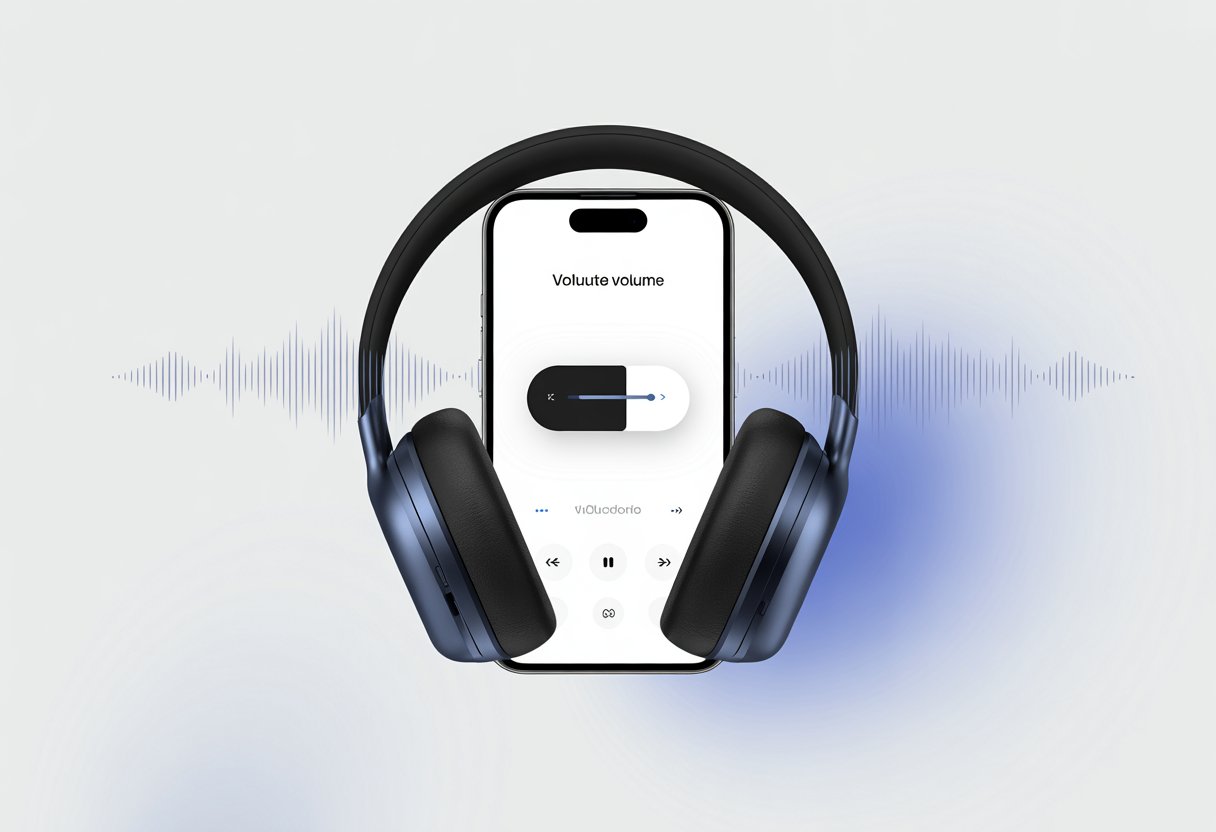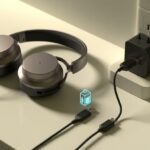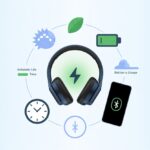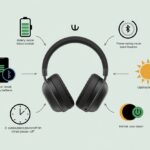We’ve all been there—sitting on the bus, trying to block out the world, and suddenly our Bluetooth headphones just aren’t loud enough. There’s nothing quite as frustrating as cranking the volume to max and still feeling like we’re listening through a pillow.
If we want our Bluetooth headphones louder, we need to check the volume on both our headphones and our phone, raise them to full, and try a few other tricks, too.

Sometimes it just feels like our headphones are holding back, keeping the real party from starting. Maybe we need to clean them, tweak a few settings, or even try a volume boosting app if it’s safe for our ears.
Either way, we’re not doomed to whisper-quiet music yet.
Let’s break down a few easy steps so we can drown out all the chaos with our own soundtracks. No need to throw our headphones out the window just yet.
Understanding Bluetooth Headphone Volume
Ever wondered why your favorite song doesn’t sound super loud even at max volume? You’re definitely not alone.
Volume control can feel mysterious, and there’s a bit more at play than just turning up a dial.
How Bluetooth Volume Works
We’ve all tried smashing the volume up button a few extra times—just hoping it’ll go higher. With Bluetooth headphones, two main things control our volume: the device (like our phone or computer) and the headphones themselves.
Both have their own volume settings, and sometimes they’re not in sync.
Most devices have separate volume control for Bluetooth and wired audio. That means turning up the phone to max doesn’t always mean the headphones are maxed out too.
Sometimes, we need to crank up both the device and headphone volumes just to hear our favorite podcast over the lawnmower.
Some phones or computers sync their volume with our headphones, so one slider rules them all. Others don’t.
If our headphones sound too quiet, maybe the headphone volume itself is napping at mid-level while our phone is partying at 100%.
Limitations of Wireless Audio Devices
No matter how much we wish otherwise, our Bluetooth headphones can’t shatter windows with sound. There’s a reason for this friendly limit.
Manufacturers set max volume levels to protect our hearing, keep audio clear, and stop us from blowing out tiny headphone speakers.
Bluetooth uses signals that sometimes lose strength or detail, especially when lots of data needs to squeeze through a small pipe. This can make wireless audio sound quieter or less punchy.
Our favorite streaming apps might also have their own max volume cap to keep things safe (and lawsuit-free).
Some devices hide built-in settings or “volume limit” features to protect young ears from the kind of rock anthems we loved in high school.
If we want to make our Bluetooth headphones louder, sometimes we need to dig into the settings, check for volume limits, or adjust the output source.
But sometimes the law (and our ears) win, no matter how much we plead.
Adjusting Device Settings for Higher Volume
Let’s face it—sometimes our favorite song deserves to be loud enough to scare the neighbor’s cat.
Getting the most out of Bluetooth headphone volume means playing around with settings on our smartphone, tablet, or laptop. We just need to make sure no volume switch stays untouched.
Maximizing Volume Controls on Your Smartphone
First, check your phone’s physical volume buttons. Push them all the way up—don’t worry, we can always blame the loud music on the dog.
On Android or iPhone, make sure you adjust the media volume instead of the ringtone or call volume.
Some smartphones sneak in a volume limiter. Let’s hunt it down:
- On Android, go to Settings > Sound & Vibration > Volume > Media Volume Limiter and make sure it’s off (if it’s there).
- For iPhones, tap Settings > Music > Volume Limit and slide that bar to the max.
We should also try syncing the phone’s volume with the Bluetooth device. On Android, there’s a Media Volume Sync setting under the Bluetooth menu. If separate, keep both device and headphone volumes high but reasonable.
Turning on this feature can sometimes fix the problem if one is stuck too low.
For more details, check the advice about volume limits and headphone settings.
Tweaking Tablet or Laptop Volume Level
Tablets and laptops love hiding their sound settings. Start by blasting the system volume to the top using keys or on-screen sliders.
If things still sound a bit too “library,” poke around the audio settings panel.
On Windows laptops, right-click the speaker icon, open Sounds or Playback Devices, select your headphones, and hit Properties. In the Levels tab, raise the volume and check for any extra Enhancements like “Loudness Equalization.”
If your Mac is acting shy, click the volume icon on the menu bar or set it in System Preferences > Sound > Output.
Try apps or built-in equalizers to tweak frequencies and gain—a sneaky way to turn up the real volume.
Keeping Bluetooth drivers updated helps too, because old software can make our music whisper instead of shout.
For step-by-step tips, check this guide to boosting headphone sound.
Headphone and App-Based Audio Enhancements
Sometimes, turning up the volume just isn’t enough. We might need a little help from headphone features, smart apps, or those mysterious equalizer settings that always seem a bit intimidating.
Using Manufacturer Apps for Extra Boost
Most Bluetooth headphone brands have their own apps. These apps do more than just ask for annoying permissions—they often give us extra volume control, sound modes, and custom settings.
For example, Sony Headphones Connect, Bose Music, or the JBL Headphones app each offer sliders and presets we can’t get from the phone’s normal settings.
When we connect our headphones with the app, look for settings like “Extra Bass,” “Loudness,” or “Ambient Sound.” Some even call it “Volume Boost” (creative, right?).
Not every headphone supports these features, but if ours does, we should use them.
We might find hidden upgrades like firmware updates that make our headphones even louder.
A tip: Stay updated. Sometimes manufacturers release app improvements with better sound enhancements. Let’s not miss out!
Equalizer Settings for Louder Sound
Adjusting the equalizer can make our headphones sound a lot louder—without blasting our eardrums into orbit.
Most music apps and phones let us play around with an equalizer, which controls things like bass, treble, and mids.
Changing these doesn’t increase the max volume number, but it makes everything feel punchier and clearer.
For a quick win, go into your settings and try a “Loudness” or “V-shaped” EQ. These pump up low and high frequencies.
If you’re feeling fancy, manually raise the sliders for the frequencies you want more of—just don’t max everything out or it might sound like a robot got into a cymbal fight.
If your headphones sound muffled, a little treble boost can help voice and detail come through.
Tweak the EQ until your favorite song feels just right.
Third-Party Volume Booster Apps
When all else fails—or when we’re trying to out-loud a jet engine—third-party apps might come to the rescue.
Apps like Bluetooth Headphones Booster can increase the sound output on both music and calls.
Some of these apps offer a simple slider, transparency so we can see the difference, and some even let us set separate volume profiles for different things (music, podcasts, movies, and so on).
We need to be careful, though. Not all apps actually make things louder; some just mess with the audio balance or add distortion.
It’s best to read reviews first and avoid anything that looks suspicious or promises “miracle” results. If it sounds too good to be true, it probably is.
Lastly, for the privacy-minded, check what data these apps have access to. If the app asks for your grandmother’s shoe size, back away slowly.
Troubleshooting Low Bluetooth Volume
Before we start blaming our headphones for quiet music, let’s look at some simple causes of low Bluetooth volume.
Sometimes, fixing small issues is all it takes to boost our sound.
Checking Bluetooth and Device Connections
Let’s make sure our headphones and devices are actually speaking the same language.
If your Bluetooth connection sounds like it’s whispering your favorite songs, try this checklist:
- Double-check both the device and headphone volume controls. Don’t let one of them fool us with a hidden low setting.
- Go into the Bluetooth settings and forget, then re-pair the headphones. It’s like rebooting our friendship.
- Make sure “Absolute Volume” isn’t enabled on Android; this sometimes limits how loud things get. You can find it in Developer Options and turn it off if needed, as many users explain in this guide for fixing low Bluetooth volume on Android.
- If you’re using an app for audio, check its own settings aren’t set to low. Sneaky!
Honestly, most volume control disasters come from small, silly settings. Sometimes the best fix is poking around in places we haven’t explored since we first connected the headphones.
Resetting Headphones the Right Way
If none of the simple fixes work, it’s time for a classic move: the reset.
Turning our headphones off and on again is the tech world’s answer to everything.
We should always check the manual (if we haven’t already recycled it) for reset instructions.
Usually, it involves pressing and holding power or volume buttons for a few seconds. Our headphones sometimes get confused and need a fresh start.
If we want to be extra fancy, unpair the headphones from all connected devices before resetting.
After that, pair them back to the phone or computer. Think of it as giving the headphones a spa day—sometimes they come back refreshed and louder than ever.
If none of this helps, our headphones might just be at “grandpa volume.” We might need new ones or a professional check, but at least we’ve given them every chance to shine.
External Solutions for Louder Audio
Sometimes, our Bluetooth headphones just can’t keep up with our need for volume.
There are a couple of hardware options that we can try out if we want to bump up the audio without fiddling with more settings or praying to the technology gods.
Upgrading to More Powerful Headphones
Let’s be honest, headphones aren’t all made equal. Some brands make headphones that sound like they’re whispering secrets, while others blast your ears like you’re front row at a rock show.
If you want more volume, upgrading to headphones with a higher maximum volume can make a big difference.
When you’re shopping for new headphones, look for ones with big drivers, low impedance, and high sensitivity ratings.
These features push out louder audio and help avoid distortion. Some popular models even brag about extra loud listening modes or bass boost—honestly, it’s like they’re daring you to test your eardrums.
If your current headphones just can’t get loud enough, it’s probably time for a gear upgrade. Some experts even suggest switching hardware.
Using External Amplifiers
Maybe you’re not into upgrading, or you’re weirdly attached to your current headphones. An external amplifier might be the trick.
Amplifiers work like personal trainers for your headphones, giving your audio a boost so it can flex at higher volumes.
You can find portable amps made just for headphones, and some are tiny enough to disappear in your pocket. Plug the amp between your audio source and Bluetooth receiver, or grab one that supports Bluetooth right out of the box.
Just don’t crank the amp too high, unless you want everyone around you to join your private concert (and probably complain). If you want more details, check out advice on using external amplifiers.
Protecting Your Ears While Going Louder
We all love to feel the beat, but our ears don’t come with a reset button. If you want to keep enjoying your favorite tunes, it helps to know how to listen safely and spot trouble before it sneaks up.
Understanding Volume Safety Limits
Honestly, sometimes we crank the volume up so loud it feels like the headphones are yelling. But experts recommend keeping things at 60% of maximum volume for safety.
Listening at high levels—especially above 85 decibels—can actually damage your hearing over time.
Here’s a quick cheat sheet:
| Volume Level | Safe Listening Time |
|---|---|
| 60% or less | 8+ hours |
| 80% | 1-2 hours |
| MAX (100%) | Under 15 minutes |
Anything above 85 decibels? Your ears might start to protest, but they’re polite about it—at least at first.
Taking breaks—think of them like coffee breaks for your ears—can really help.
Signs of Unsafe Listening Levels
Ever finish a jam session and suddenly everything sounds like you’re underwater? That’s a pretty big clue we’ve gone too far. If your ears are ringing, things sound dull, or you keep asking, “What?” at dinner, your body’s waving some red flags.
When you feel pain or notice voices getting muffled, it’s probably time to turn the volume down. Headphones should make us happy, not land us in the ear doctor’s waiting room. If you have to yell over your music, or someone nearby can sing along to your playlist, you’re definitely cranking it too loud.
Spotting these signs early helps us keep listening—and maybe avoid those classic family lectures about “kids these days.”
- Best Bluetooth Headphones for Side Sleepers: Snooze in Stereo Without the Sore Ears - December 2, 2025
- Best Fitness Trackers for Kids Who Move Faster Than Your Wi-Fi - December 1, 2025
- How to use Bluetooth headphones with gym equipment without looking like a techno-ninja - December 1, 2025






